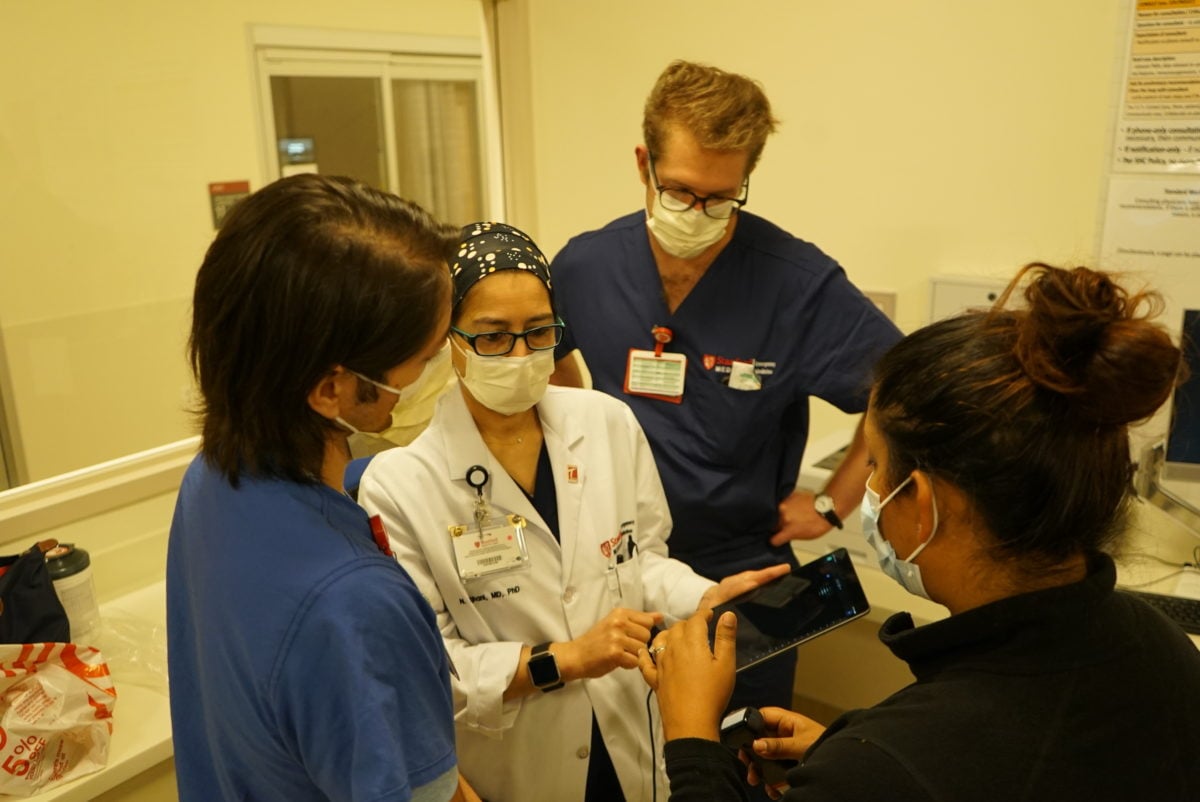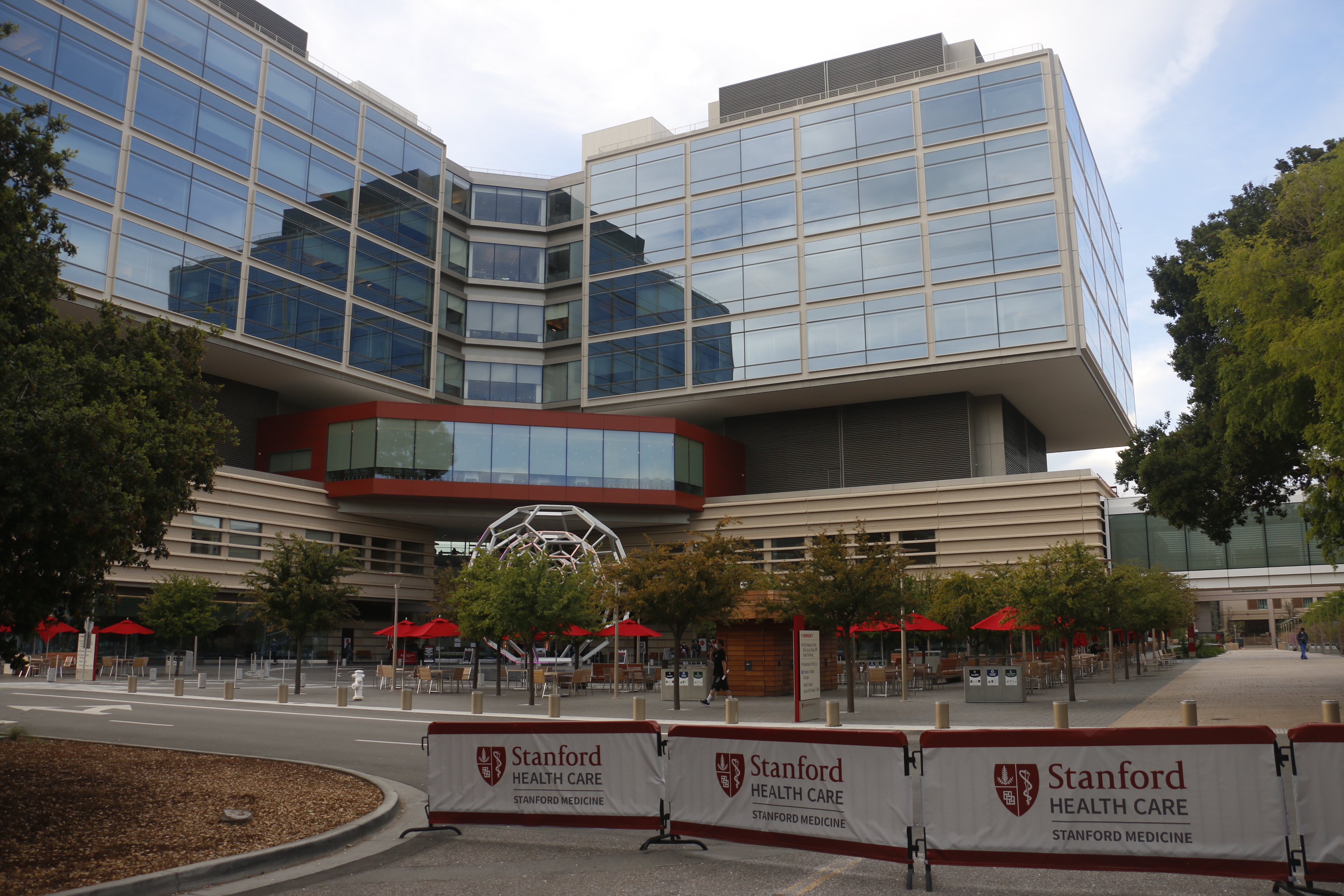“Going to the hospital is a little eerie,” said Amy Filsoof, a chief resident at Stanford Hospital. “It just feels empty.”
“It’s just very quiet,” agreed internal medicine hospitalist Charles Liao.
From the outside, Stanford Hospital looks to have taken on the same somber quiet as the rest of the Bay Area. With the threat of coronavirus transmission keeping families and non-essential patients away, plazas and lobbies sit empty, and the din of conversation and activity has given way to nervous silence.
Seen against harrowing scenes of hospitals overwhelmed on the East Coast, it is an encouraging stillness. But it belies the intensity of Stanford Hospital’s battle against coronavirus and the toll it has taken on the physicians leading the charge.
In interviews with The Daily, doctors described a frantic preparation effort fraught with uncertainty and change. They have responded with optimism and camaraderie.
‘Quiet before the storm’
Four weeks after six Bay Area counties issued the nation’s first shelter-in-place order, Stanford Hospital’s calm exterior is an encouraging sign that the Bay Area has avoided the plight of the nation’s worst-affected regions. As of Wednesday, 5,735 cases of COVID-19 have been reported in the Bay Area, according to The Mercury News.
“The theme has kind of been the quiet before the storm,” Liao said.
The shelter-in-place order bought Stanford Hospital valuable time to prepare for possible surges in COVID-19 cases.
“There’s been an extraordinary amount of amazing preparation in a very short amount of time,” said associate chief quality officer Amy Lu.
“We have 7 a.m. huddles where we discuss what’s our numbers, how many ventilators do we have, how many intubated patients,” said hospital medicine division chief Neera Ahuja.
Logistical challenges have included expanding testing capacity, acquiring ventilators and personal protective equipment (PPE) — doctors described Stanford Hospital’s current supply of PPE as “promising” — and creating “surge teams” of additional hospital staff.
“At any given time, I have a list of all of our internal medicine residents who could be pulled from what they’re currently doing to serve on a surge team within hours,” Filsoof said. “The same is true for the ICU team.”
Part of the challenge has been adjusting the hospital’s planning to constantly shifting projections of the number of patient and COVID-19 cases.
“Every day, we’re monitoring the hourly arrivals and census in the ED [emergency department], divided up by COVID and non-COVID patients,” said assistant medical director Ryan Ribeira. “And then we use a three or four day moving average to project what our volume of each patient type is going to be in the coming days, and staff to that.”
Most doctors expressed confidence in the hospital’s preparations, though some stressed the continued unpredictability of coronavirus’ spread.
“We’re trying to stay cautiously optimistic,” Ahuja said. “But in a week, anything could happen.”
‘Building the plane while we’re flying it’
As in institutions across the country and the world, uncertainty initially pervaded Stanford Hospital’s response to coronavirus, forcing doctors to study and innovate on the fly.
Filsoof described the experience of the past month as “trying to find footholds in the face of extreme uncertainty.”
“It’s felt a little bit like we’re building the plane while we’re flying it,” she said.
Filsoof treated one of Stanford Hospital’s earliest COVID-19 patients in early March, encountering the disease for the first time when it was still new and poorly understood.
“We were still learning how to don and doff personal protective equipment,” she said. “There was a lot of fear and anxiety about doing that well … there was a lot of uncertainty about who should be going in the room, how many providers should go in the room, how frequently should we go in the room.”
New systems of treatment and guidelines establishing how to treat and manage exposure to COVID patients had to be developed quickly.
“Fast forward to only maybe three or four weeks later … we have protocols for who should go in the room, how often, and we also have the ability to do Zoom chats with patients to minimize provider exposure and PPE use,” Filsoof said. “That elaborate system was built in the order of days to weeks.”
Telemedicine, the use of video calls to deliver consultations and treatment to patients remotely, has rapidly become a fixture of Stanford Hospital’s overhauled workflows. iPads mounted in wards and Zoom calls allow providers to care for patients while preserving PPE and minimizing exposure, and connect patients to families no longer allowed to visit the hospital.
Like the hospital’s new COVID-19 treatment protocols, telehealth procedures were implemented in a matter of weeks.
“We essentially had no telehealth in our emergency department prior to three weeks ago,” said Ribeira, who helped oversee the installation of Stanford Hospital’s telemedicine systems. “Typically, doing something like implementing a telehealth program is like a nine-month project.”
“It was a lot of long hours,” he said. “… Every day feels like a week right now.”

‘This is what we signed up for’
Doctors were candid about the pressures of treating COVID-19 patients and taking on increased workloads over the past month.
“It is a little bizarre,” Ribeira said. “… There’s a risk of personal harm from this that we’ve not really had to experience before.”
At the end of long shifts, personal lives have strained as well. At home, teleconferences and emails occupy Ahuja into the late hours of the night. Ribeira changes his newborn’s diapers — “this is usually the time when I would be on paternity leave” — wearing an N95 mask.
The fear of falling ill, or bringing coronavirus to their families, weighs heavily on many.
“I had to get tested twice,” Liao said. “I had symptoms, and getting tested means you have to self-quarantine and not come to work. The fear of exposing yourself to your family has been very difficult.”
“What are we going to do … if I or my wife or both of us are sick?” Ribeira said. “Who takes care of our kids? The hard part is that we don’t really have good answers.”
Despite this, the mood at Stanford Hospital has remained positive. Doctors described an atmosphere of stoic camaraderie: nods of solidarity in the hallways, physicians volunteering for extra shifts outside of their departments, medical school students organizing collection drives and babysitting for staff.
“Everyone just feels really on the same team and working towards a common goal,” Filsoof said. “I think to some degree that always exists in healthcare, but I feel it even more strongly right now.”
Doctors expressed gratitude for the ability to take action during the pandemic, even as it has brought much of the rest of the country to a paralyzing halt.
“I think we’re all grateful to have this opportunity to take care of each other and our patients during this time,” Lu said. “I definitely feel fortunate to have a role in this. All of us do.”
“This is what we signed up for,” Ahuja said. “… When we work long hours both during residency and post-residency, for those of us that love our jobs, this is what we’re here for.”
‘One day at a time’
The resilience of Stanford Hospital’s staff hasn’t been for naught. State leaders have begun to express cautious optimism over recent days as Bay Area patient numbers stay below anticipated highs. But given their immediate concerns, doctors aren’t looking too far ahead.
“I think it’s hard to look much beyond today, much less tomorrow or three months from now,” Filsoof said. “But I almost think taking it one day at a time is how we’re able to cope and sustain what needs to be done.”
Impacts from the coronavirus response will linger at Stanford Hospital beyond the end of the pandemic. Many departments plan to incorporate improvements to their treatment facilitated by the hospital’s new telemedicine systems, according to Ribeira and Ahuja.
One longer-term concern is the potential of a “post-COVID rebound” of non-COVID patients who haven’t been able to come into the hospital for lower-priority treatment over the lockdown.
“A lot of routine outpatient visits have been put off, probably appropriately,” Filsoof said. “Whenever that resumes, I think there’s going to be a lot of people who need non-COVID related care and I think we’re going to be busy.”
For now, the hospital’s quiet but vigorous battle against coronavirus continues. When Stanford Hospital’s doctors are finally able to stand down, there will be much to look forward to.
“Honestly, I’m mostly looking forward to hanging out with my newborn when it’s over,” Ribeira said. “Being able to be around him and not wear a mask, and being able to finally take my paternity leave.”
Contact Daniel Wu at dwu21 ‘at’ stanford.edu.
